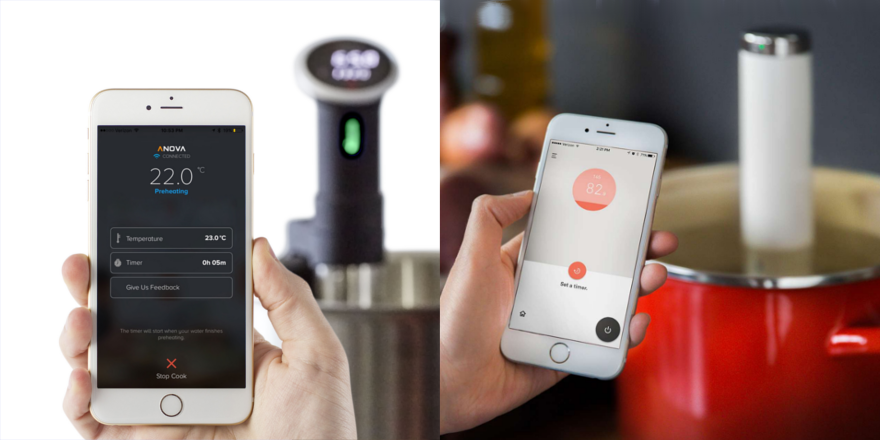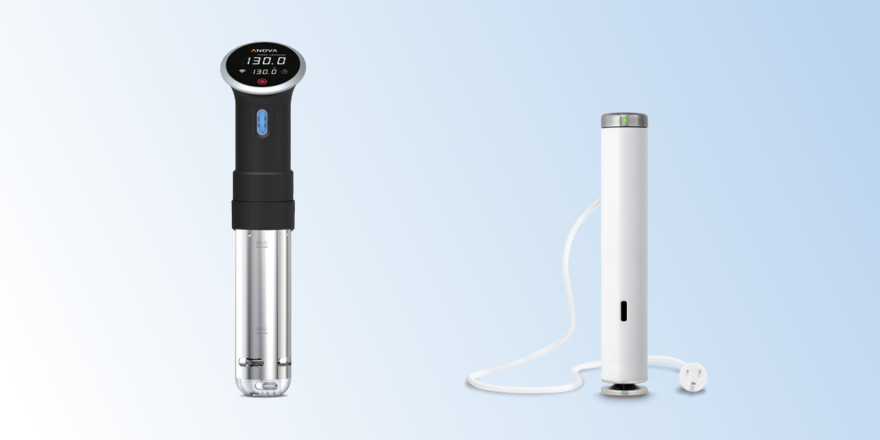The attraction behind Sous Vide cooking is the ability to maintain a constant, precisely-controlled temperature. This takes a lot of the guesswork and finesse out of cooking, and allows home chefs to achieve beautiful, consistent results each and every time.
This “Sous Vide Showdown” will focus on two immersion circulators — the Anova Precision Cooker Bluetooth + Wi-Fi vs. ChefSteps Joule. Immersion circulators heat a water bath to the desired temperature and allow precision cooking of food in a vacuum sealed bag. These models are less expensive than more professional-grade options at only $200, and offer a great way to get started in the world of Sous Vide cooking. Let’s take a look at some of the major differences between the Anova and Joule.
Anova vs. Joule — Differences
-
Difference #1: Storage – Storage capacity is a major consideration when looking for a Sous Vide cooker. Making sure the device provides adequate cooking room while remaining compact and easy to store is an aspect that sets a great cooker apart from the rest.
There’s a decent amount of difference in the storage and design of these cookers. The black and stainless-steel Anova measures 14.75 inches long and weighs 2.5 pounds.
The Joule’s design trends towards a streamlined and smaller look at the expense of some onboard functionality. It measures 11 inches long and weighs about 1.3 pounds.
While the Anova may have some more comprehensive features, it won’t fit in smaller drawers, making it a bit more difficult to store than the Joule.
-
Difference #2: Control Type – The Anova’s larger size, while sometimes inconvenient, allows the device to accommodate an LCD control screen and scroll wheel that allows for easy control of the unit’s temperature.
The Joule, on the other hand, depends on its app for operation. The only button on this model is the one to turn it on — setting the temperature is left to your phone.
The Anova is controllable via app, too, but the fact that it gives users the option to operate it manually makes it the clear winner in this difference.
-
Difference #3: Attachment – Both immersion circulators have the ability to clip to the side of the pot or container you’re using for a water bath.
The Joule features a simple wireform clip that will fit most any pot. However, the Joule offers an additional method of attachment via a magnet that allows it to stand straight up in a metal pot (provided the pot is magnetic, of course!) This is a great option for smaller containers that aren’t very deep.
The Anova uses a screw clamp which is a little slower and clunkier to set up than the Joule’s simple wireform option. This format does have an advantage, however, in that the clamp mounting bracket allows for a perfect fit on wide or thin-lipped containers.
With the Joule, you’ll have to buy a clamp separately for wider containers, while the Anova can handle these larger tasks right out of the box.
Either device can handle large containers with ease — provided you have the right equipment — but the Joule comes out ahead with the handy magnetic feature and convenient wireform clip.
-
Difference #4: Apps – While the Joule lacks any form of manual control for its immersion circulator, the app is beautiful and fully-featured. While the Anova app includes pictures in its guides and recipes, it really can’t compete with the snappy videos that accompany every step in the Joule’s guides.
Newcomers to the world of sous vide may be better served by the Joule’s more comprehensive smartphone app.
-
Difference #5: Display – The Anova definitely wins in the display category — since it actually has one! The digital screen tells you your target temperature, current temperature, and remaining cooking time. As mentioned above, it’s possible to set the temperature and timer using the little wheel on the Anova, allowing for easy control even without a smartphone.
The Joule is only controllable via the smartphone app, and it’s honestly a little disappointing to not have that visual indicator. While not necessary by any means, it’s a nice touch that makes the Anova feel a little more “premium” aesthetically when compared to the Joule.
-
Difference #6: Circulation/Heat Power – One major aspect to take into account is how well the immersion circulator heats and maintains temperature.
The Joule pulls ahead in this section with an extra 300 watts in power. This translates to a heating speed roughly twice as fast as the Anova, which is pretty significant. The device was able to heat four liters of water to 132.8 F (the temperature recommended for cooking a medium-rare steak) in 10 minutes, while the Anova takes around 20 minutes to achieve a similar cooking temperature.
The Anova has a slight advantage in that it can technically heat water 16 degrees hotter than the Joule, but the practical applications of this little bit of extra temperature aren’t significant enough to make up for the slower heating speed.
-
Difference #7: Plug Configuration – Currently, the Joule is only sold in the United States. The company has plans to expand into other markets, but there’s currently no firm ETA.
The Anova, on the other hand, has four plug configurations: 120v USA/CA, 220v AU, 220v EU/Korea, and 220v UK, making it the more versatile of the two.
-
Difference #8: Connectivity – Both sous vide systems connect with smart home devices.
The Anova can connect with systems like Amazon Alexa and Google Home. Being able to ask Alexa to set your cooker to a certain temperature is a convenient feature that makes setting up your circulator that much easier.
Although the manufacturer has plans to eventually support Google Home, the Joule currently only works with Amazon Alexa, lacking support for other smart home systems. If smart home functionality is important to you, the Anova is generally more comprehensive in its integration.
-
Difference #9: Detachable Cord – The Anova’s detachable cord is a nice feature, allowing for easier and safer cleaning of the device when compared to the Joule.
-
Difference #10: Fill Capacity – Though relatively similar in capability, there are some differences in maximum and minimum fill capacity when comparing the Anova and Joule.
The Anova has a minimum fill of 2.75 inches and a maximum fill of 6.25 inches, while the Joule features a minimum of 1.5 inches and a maximum of 8 inches.
The Joule comes out on top in this category with a wider range of fill capacities, allowing for more flexibility when it comes to sous vide cooking.
Anova vs. Joule — Comparison Table
| Anova Bluetooth + Wi-Fi | ChefSteps Joule | |
|---|---|---|
| Display | LCD display, LED backlit scroll wheel | No |
| Control Type | Manual Anova app |
Joule app |
| Size | 14.75” x 2.75” | 11.0” x 1.85” |
| Weight | 2.5 lbs | 1.28 lbs |
| Material | Stainless steel and polycarbonate | Stainless steel and food-safe plastic |
| Auto Shut-off | Yes | Yes |
| Power | 900 Watts | 1100 Watts |
| Maximum Temperature | 210° | 208° |
| Minimum Fill | 2.75” | 1.5” |
| Maximum Fill | 6.25” | 8” |
| Type of Clip | Adjustable ring clip | Magnetic foot cling & clip |
| App | iOS 9.0 or later for Wi-Fi, Android 4.3 and later |
iOS 8.0 or later, Android 4.4 or later |
| Power Input Options | 120v USA/CA 220v AU 220v EU/Korea 220v UK |
120v USA/CA |
| Works with Amazon Alexa | Yes | Yes |
| Works with Google Home | Yes | No |
Anova vs. Joule — Our Thoughts

At the end of the day, both devices will serve you well. The Joule is smaller and packs a bigger punch, but requires an app to use. It’s newer, lighter, and smaller than the Anova which makes it a great choice despite its lack of display.
The fact that the Joule necessitates app usage is unfortunate, but the greater degree of flexibility, ease of use, and more convenient storage generally makes it the better option for most customers.
Both sous vide cookers have their pros and cons, and which device will work best for you is largely a personal decision. Both options provide painless and inexpensive access to sous vide cooking, and will put you well on your way towards restaurant quality food in the comfort of your own home.
Want to see how other sous vide machines stack up? Check out our Compare Sous Vide page.
Last update on 2024-04-23 at 07:19 / Affiliate links / Images from Amazon Product Advertising API




chose the anova. I love it. But i also keep the Joule app on my phone next to the Anova app. The joule app is way better and informative. I look at that app first then set my Anova.
Good news, Joule is now available in the EU/UK (220-240V) and has Google Home support!!
Check Cinder out. Super easy to use, nice and portable too. Once the seasoning is complete on the griddle… it becomes nearly like teflon, even scrambled eggs don’t stick!